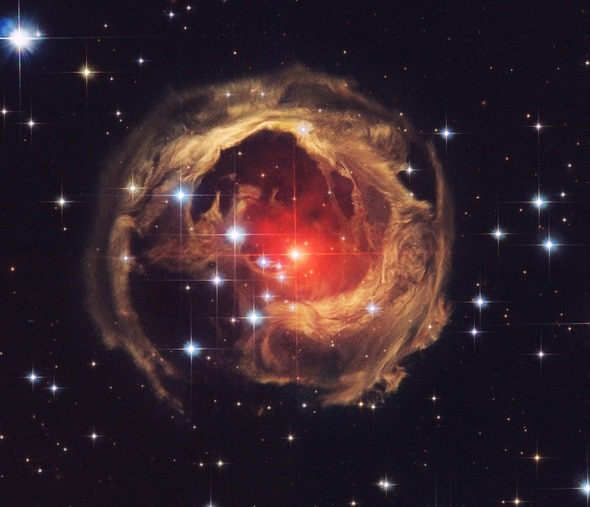Create a free profile to get unlimited access to exclusive videos, sweepstakes, and more!
Bad Astronomy Video: The Bizarre Eructation of V838 Monocerotis

Something like 20,000 light-years from Earth lies a bizarre object.
Dubbed V838 Monocerotis—the 838th variable star found in the constellation Monoceros, the unicorn—it’s a luminous red star, well over 20,000 times brighter than the Sun.
That’s not so unusual; lots of stars are far more luminous and redder than the Sun. It’s also centered in a cloud of material, which, again, isn’t all that odd. Lots of stars have material around them, wither left over from their formation, or expelled as they die.
What makes this star so weird is its recent activity. In 2002 it underwent an epic eruption, brightening to a million times the luminosity of the Sun. Astronomers thought it might be a nova, an outburst caused when a tiny white dwarf accumulates matter on its surface, which explodes quite literally like a thermonuclear bomb.
When this happened, in 2002, Hubble was quickly called to service, pointing at the object. What it found was not a nova, but one of the oddest stars in the galaxy. Watch:
There are lots of things that could have happened to cause this event. Red supergiants are known to undergo periodic paroxysms, for example, but such things are generally not this powerful. Plus, whatever caused it must be something rare, or else we’d see more examples of it. That’s why I lean toward the stars-merging idea discussed in the video. It’s rare, but not impossible, and does explain what we’re seeing.
And to reiterate something I said in the video: What we’re seeing here is what’s called a light echo. The dust cloud around the star is old, probably thousands of years old. When the star suddenly brightened, it sent out a flash of light that moved outward, illuminating the pre-existing cloud from the inside out.
In the video it looks like the cloud itself is expanding (you can see motion of individual structures), but that's an illusion. Over just a few years the structure wouldn’t be seen to expand at all; we’re just seeing different structures (or different parts of the same structure, like filaments or compressed regions) as the flash of light moved through the nebula.*
It's pretty odd but adds to the overall awesomeness of it. And it’s a good reminder, in this 25th anniversary week of the Hubble Space Telescope, that the Universe is vast and strange and beautiful, and best of all, surprising.
We could have 25 Hubbles up there for 25 times 25 years and still only have scratched the surface of what’s out there to see.
*As opposed to objects like novae and supernovae which have been seen to physically expand over time.


























